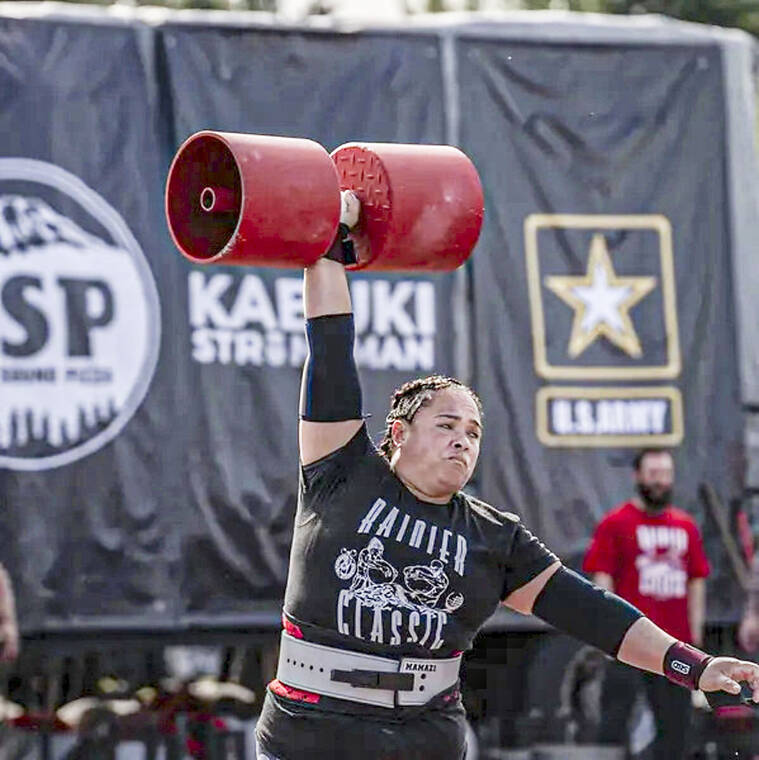Standing strong: Physical therapist finds joy competing in Strongman events

Contributed photo Dr. Shauna Russell lifts a loaded dumbbell during the 2022 Rainier Classic.
Strength and exercise are Dr. Shauna Russell’s lifestyle and calling.
Strength and exercise are Dr. Shauna Russell’s lifestyle and calling.
When she’s not running her practice — Big Island Physical Therapy — she trains for and competes in Strongman competitions.
ADVERTISING
Earlier this month, she competed for her second time in the Rainier Classic — a Strongman competition in Seattle which attracts competitors from across the country — and placed second in the Amateur Women’s Open division.
“We had to do log clean and press,” she said. “The log was 185 pounds. We had to do kegs with a chaos keg — it’s filled with water, river rocks and lead shot, so it’s very unstable. Ours was 90 pounds.
“We had to ride an airbike for 15 calories, and then our class had to pick up a 225-pound sandbag and walk as far as you could in 90 seconds. We had to throw a 30-pound sandbag over a 12-foot pole for distance and for height. We also had a trap bar deadlift. I think ours was 405 (pounds).”
Russell completed six high-handle reps of the 405-pound deadlift.
Very few men can even deadlift 405 for a single rep — and for women, doing so is widely considered to be elite and nationally competitive.
Russell got into Strongman nearly three years ago, transitioning away from her background in powerlifting.
Strongman and powerlifting require a very similar set of capabilities, but are highly different in their execution. Powerlifting focuses on the ‘big three’ exercises — bench press, back squat and deadlift.
Strongman blends elements of powerlifting with Olympic weightlifting and the old-school styles of highland games and the like. It is less stationary than powerlifting, incorporating multi-directional movement into its strength challenges.
While powerlifting competitions are very standardized in their processes, every Strongman competition is a bit different, with varying lifts.
“I had never seen a Strongman competition except for on TV,” Russell said. “I realized that you only had to do everything once, and the longest things were usually 60 seconds. So, I tried it — and I liked it. It pushed me more than powerlifting, with the difference between static strength and the ability to move and be strong.”
She also competes in Hawaii at competitions put on by Hawaii’s Strongest in Hilo and Kona, as well as competitions on Oahu.
Her goal is to continue training hard and competing in order to qualify for the 2024 Strongman Corporation Nationals.
Though she has qualified before, she wants to feel truly prepared to succeed before diving in.
“I could go this year, but I don’t feel ready yet,” Russell said. “A lot of times, the nationals are in Pennsylvania and other random parts of the East coast. If I’m gonna go all the way out there, I want it to be worth it. I don’t wanna just waste my time and money.”
This year at the Rainier Classic, the culture was one of Russell’s favorite things to experience.
“The community there — and not just there, but everywhere in Strongman — everyone is super competitive,” she said, “but, even the people you’re competing against cheering for you. We’re all trying to share ideas for how to pick up ridiculously heavy objects that look weird. Everybody’s body type is different, so everyone has different technique, even though the general idea is the same.
“That’s what I like about it, it’s not so ‘me versus you.’ It’s really you versus you. Everyone’s trying to help you do the best you can.”
Raised on Maui, Russell moved to Hilo in 2014 and opened her practice in 2016. Prior to that, she ran a practice on Molokai — and on Maui before that.
When she moved to the Big Island, she was still running both her other clinics on Maui and Molokai. She bought the Hilo practice from its last owner, but had to give up her off-island practices in order to have time for her family.
“I had to sacrifice those other clinics,” Russell said. “This clinic was a lot bigger than both of those, so I had to make a decision.”
At her current practice, she sometimes gets to implement elements of Strongman training into her clients’ routines.
“I incorporate a lot of my Strongman stuff into my therapy so that people aren’t afraid to use certain things,” she said. “I have ladies in their 80’s picking up sandbags and carrying them. I’ve also gotten some of my other therapists to try those things.
“I always just want people to be strong. That’s kind of the purpose of everything. Most of our patients are really afraid to go to the gym because they don’t know what to use. In here, because we put them in an area with heavy weights, racks and everything — they realize they don’t have to feel so intimidated.”
Russell does her own training at her practice, and also trains at Imua Iron in Kona on weekends.
“What people don’t realize with strongman is that you train the same as powerlifting,” she said. “I still deadlift, I still squat, I still bench and do all the accessory lifts. Throughout the week, you’re just gaining strength. On the weekends, we use that strength training to train for events and play with the toys.”
Russell hopes that her success and passion for strength will inspire other women, and correct any misconceptions that they may have been given.
“People associate strength sports with big, steroids, huge men,” she said. “I just want to be an example for women, because being strong doesn’t necessarily mean you’re manly.
“Being strong is a lifestyle. For women especially, you can still be feminine and be strong.”


